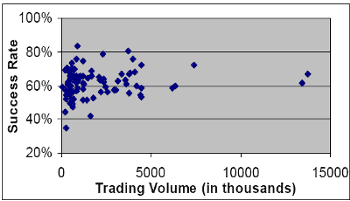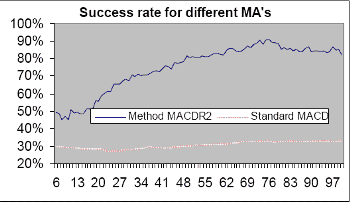Another interesting question is whether the success rate of model MACDR2 is positively correlated to the trading volume of a stock. The reasoning is that the higher the trading volume, the more technical analysis is used in the trading decision. However, all regression coefficients indicated no significant correlation.

Figure 5: Success rate of model MACDR2 with respect to trading volume; Target gain 3% Figure 5 confirms that the trading volume theory cannot be supported.
Traditional MACD and Method MACDR2 for Different Moving Average Time Periods
In trading practice, traders usually use the difference between the 26 and 12-day exponential moving average to derive the MACD1 indicator. Then the 9-day moving average of the MACD1 indicator is calculated and called the Signal indicator. An interesting question is whether moving averages of different time lengths give better trading results regarding the traditional MACD indicator as well as our method MACDR2.
In our study we tested moving averages from 5 days to 100 days, leaving the proportion of 26, 12, and 9 unchanged, rounding to the nearest integer. Figure 6 shows the results of the different moving averages. The horizontal axis represents the time lengths of the moving average. The numbers on the horizontal axis reflect the longest average. For example, the number 55 represents the average combination 55, 25 and 19.

Figure 6: Success rate of the traditional MACD and method MADCR2 for different moving average time periods.
From Figure 6, we can see that the traditional MACD does not improve for different moving averages. The success rate is fairly constant around a disappointing 30% level. Figure 6 also shows a slightly positive correlation of method MACDR2 (with a 1.5% crossing level) with longer moving averages. The best result is achieved using the moving average combination 73, 34 and 25. Here the success rate is 90.74%.
Gunter Meissner, Albin Alex and Kai Nolte
Next: Model MACDR2 and the Random Walk Hypothesis
Summary: Index